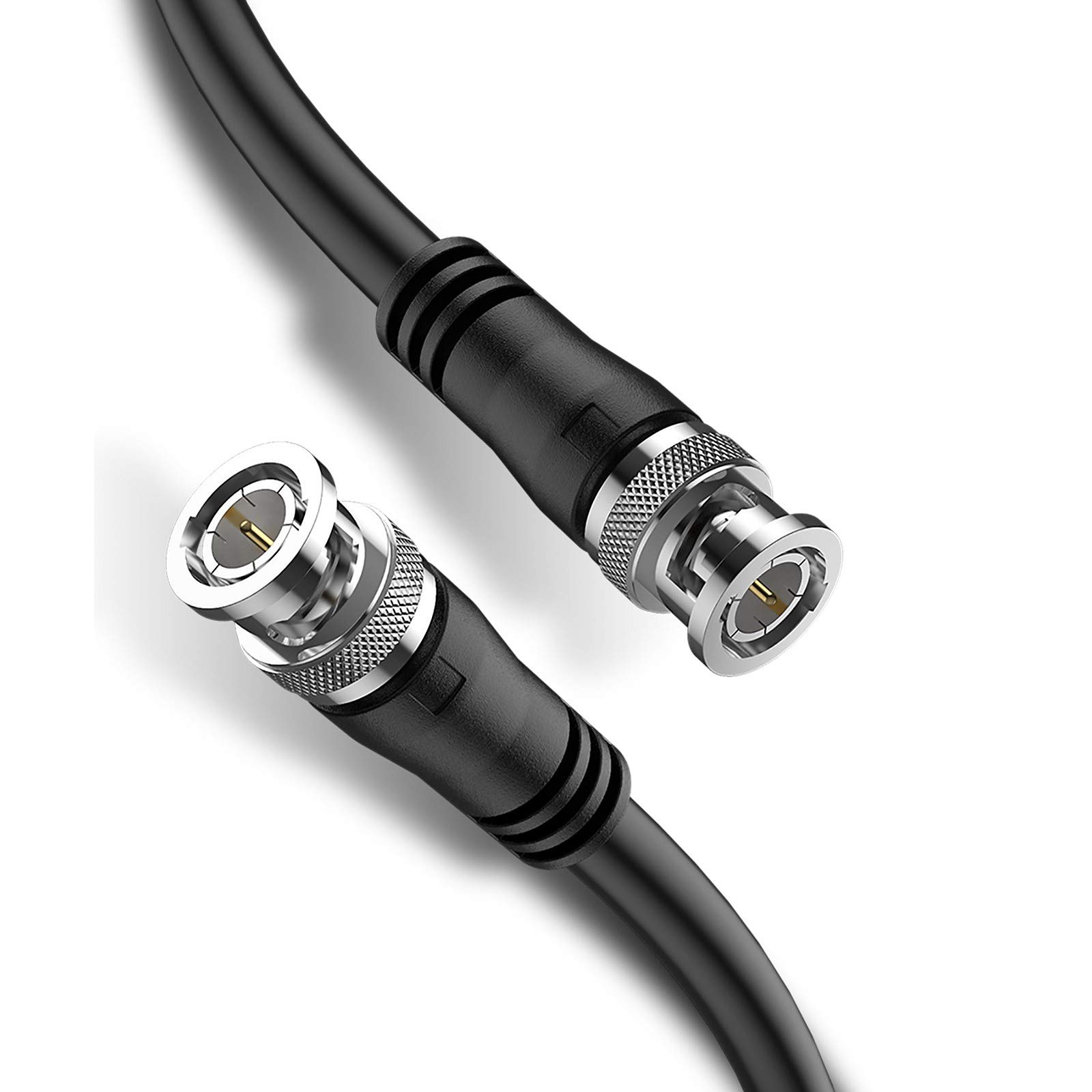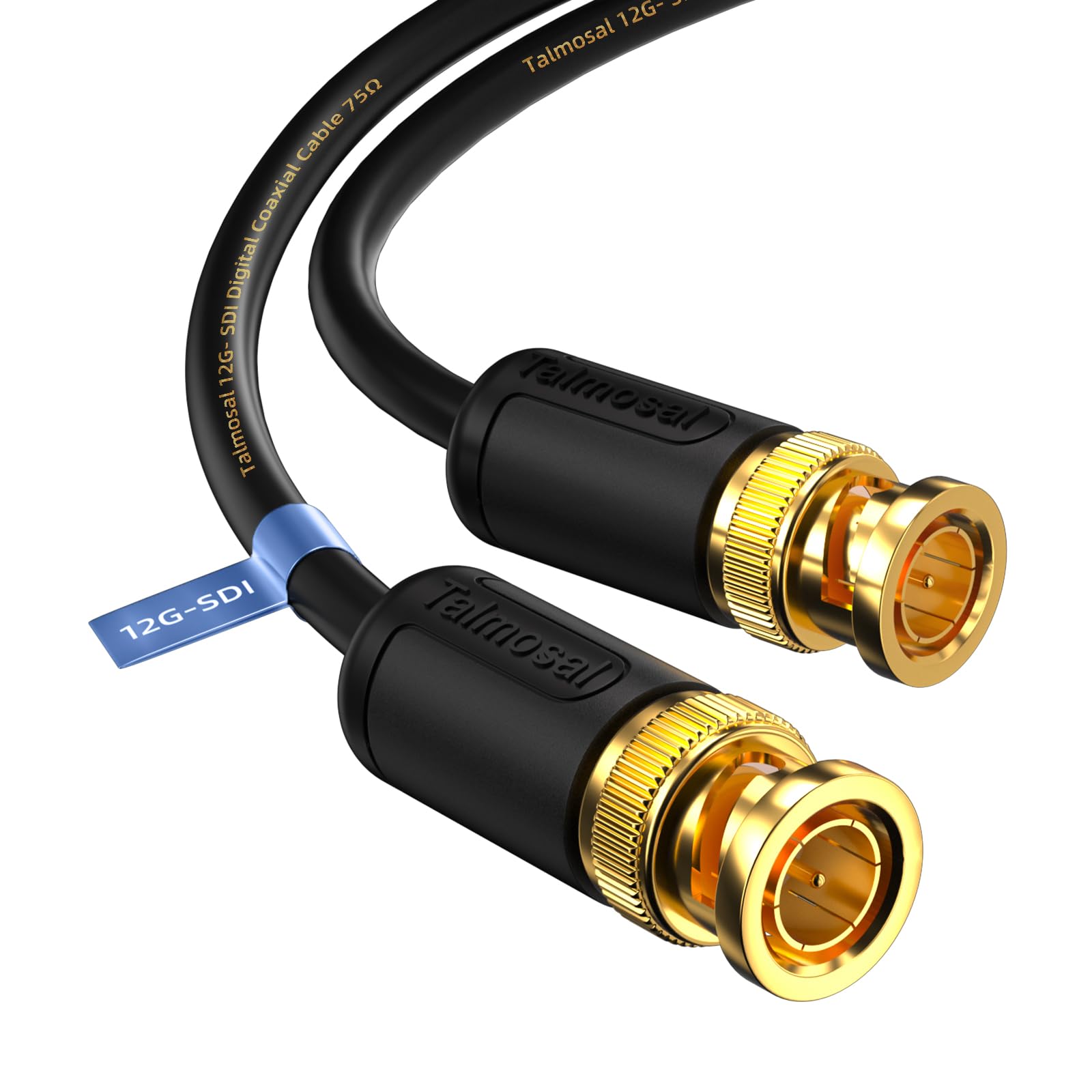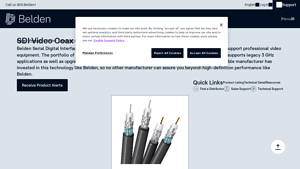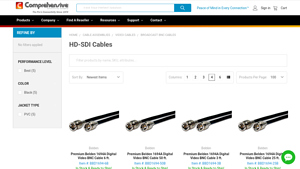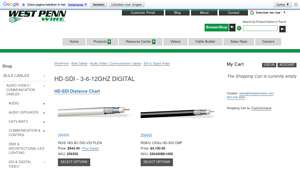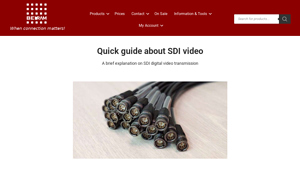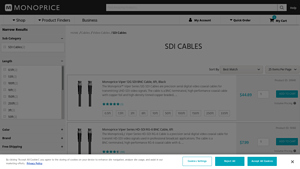Sdi Cable Guide: Type,Cost,Material…
Introduction: Navigating the Global Market for sdi cable
Navigating the complexities of sourcing SDI cables can be a daunting task for international B2B buyers, especially when ensuring compatibility with advanced video transmission systems. As the demand for high-definition and ultra-high-definition video content surges across various sectors, understanding the different types of SDI cables—such as 3G, 6G, and 12G—becomes crucial. This comprehensive guide will delve into the intricacies of SDI cables, covering their various applications in broadcasting, live events, and surveillance systems, while also providing insights on how to effectively vet suppliers and assess pricing structures.
In today’s competitive global market, especially for buyers in regions like Africa, South America, the Middle East, and Europe, making informed purchasing decisions is paramount. This guide aims to equip you with the knowledge necessary to navigate the landscape of SDI cables, helping you identify reliable suppliers, understand the technical specifications that matter most, and evaluate cost-effective solutions without compromising on quality. By the end of this guide, you will be empowered to make strategic choices that enhance your operational capabilities and ensure seamless video transmission across your projects, no matter where you are in the world.
Understanding sdi cable Types and Variations
| Type Name | Key Distinguishing Features | Primary B2B Applications | Brief Pros & Cons for Buyers |
|---|---|---|---|
| 3G-SDI | Supports up to 3 Gbps, 1080p resolution | Broadcast studios, video production | Pros: Cost-effective, widely compatible. Cons: Limited future-proofing for 4K applications. |
| 6G-SDI | Handles up to 6 Gbps, supports 4K at 30fps | Live events, high-definition broadcasts | Pros: Enhanced bandwidth for 4K; reliable signal quality. Cons: Higher cost compared to 3G-SDI. |
| 12G-SDI | Up to 12 Gbps, supports 4K/8K resolutions | High-end video production, sports broadcasting | Pros: Future-proof for ultra-high-definition; excellent performance over long distances. Cons: Requires specialized cables, more expensive. |
| HD-SDI | Uncompressed video signals, 1.5 Gbps | Professional video equipment | Pros: Reliable for HD signals; standard in many setups. Cons: Limited to HD; not suitable for future 4K demands. |
| Shielded SDI | Additional shielding for interference protection | Commercial AV installations, critical broadcast environments | Pros: Superior signal integrity; durable for field use. Cons: Slightly higher price point; may be overkill for simpler setups. |
What Are the Key Characteristics of 3G-SDI Cables?
3G-SDI cables are designed to transmit high-definition video signals at a maximum bandwidth of 3 Gbps, supporting resolutions up to 1080p at 60 frames per second. This type is commonly used in broadcast studios and video production environments due to its cost-effectiveness and compatibility with existing infrastructure. When purchasing 3G-SDI cables, buyers should consider the longevity of their current systems, as this standard may not suffice for future 4K requirements.
How Do 6G-SDI Cables Enhance Video Quality?
6G-SDI cables provide enhanced bandwidth capabilities of up to 6 Gbps, accommodating 4K video at 30 frames per second. This makes them ideal for live events and high-definition broadcasts where superior image quality is essential. Buyers should evaluate their current and future video production needs, as opting for 6G-SDI can offer a balance between cost and performance, especially for organizations planning to upgrade to 4K workflows.
Why Choose 12G-SDI Cables for High-End Productions?
12G-SDI cables stand out by supporting bandwidths of up to 12 Gbps, enabling the transmission of ultra-high-definition signals, including 4K and 8K resolutions. They are primarily utilized in high-end video production and sports broadcasting, where exceptional image quality is paramount. Buyers should consider the investment in 12G-SDI as a future-proof solution, especially if they anticipate moving towards advanced production techniques and technologies.
What Are the Advantages of Using HD-SDI Cables?
HD-SDI cables are built for transmitting uncompressed video signals at 1.5 Gbps, making them a reliable choice for professional video equipment. They are commonly found in setups that primarily handle HD content. However, buyers should be aware that while HD-SDI cables are dependable, they may fall short in accommodating higher resolutions, necessitating careful consideration for future upgrades.
How Do Shielded SDI Cables Improve Signal Integrity?
Shielded SDI cables incorporate additional shielding to protect against electromagnetic interference, ensuring superior signal integrity, particularly in commercial AV installations and critical broadcast environments. Their robust construction makes them suitable for both permanent installations and field use. While they may come at a higher price point, the investment is justified for buyers who prioritize reliability and performance in challenging environments.
Key Industrial Applications of sdi cable
| Industry/Sector | Specific Application of SDI Cable | Value/Benefit for the Business | Key Sourcing Considerations for this Application |
|---|---|---|---|
| Broadcast & Media | Live Sports Broadcasting | Ensures real-time transmission of high-definition video signals, enhancing viewer experience. | Compatibility with existing infrastructure and support for 12G SDI for future-proofing. |
| Film Production | On-Set Video Monitoring | Facilitates the connection between cameras and monitors for immediate feedback during shoots. | Durability and flexibility for extensive use in dynamic environments. |
| Security & Surveillance | Camera Systems for Security Monitoring | Provides reliable video transmission over long distances, crucial for effective surveillance. | Shielding and resistance to interference in urban environments. |
| Event Production | Multi-Camera Live Event Streaming | Enables seamless integration of multiple video feeds for live broadcasting or streaming. | Support for various SDI standards and cable lengths for flexibility in setup. |
| Educational Institutions | Distance Learning and Virtual Classrooms | Transmits high-quality video signals for remote learning applications, enhancing educational delivery. | Scalability and compatibility with various AV equipment used in educational settings. |
How is SDI Cable Used in the Broadcast and Media Industry?
In the broadcast and media sector, SDI cables play a crucial role in live sports broadcasting. They enable the transmission of high-definition video signals from cameras to broadcasting equipment in real-time, ensuring that viewers receive high-quality footage without lag. This application is vital for enhancing the viewer experience during live events. Buyers in this sector should consider sourcing cables that support high bandwidth, such as 12G SDI, to future-proof their investment against evolving broadcasting standards.
What Role Does SDI Cable Play in Film Production?
During film production, SDI cables are essential for on-set video monitoring, connecting cameras to monitors for instant feedback. This capability allows filmmakers to make immediate adjustments to shots, improving overall production quality. For international buyers, particularly in regions like Africa and South America, the durability and flexibility of SDI cables are key considerations, as they often work in varied environments where equipment can be subjected to rough handling.
How Do SDI Cables Enhance Security and Surveillance Systems?
In security and surveillance applications, SDI cables facilitate the transmission of video signals from cameras to monitoring stations over long distances. This is critical for maintaining video quality and reliability in urban environments where interference may occur. Businesses sourcing SDI cables for security systems should prioritize options with robust shielding to minimize signal loss and ensure uninterrupted monitoring, especially in high-density areas in the Middle East and Europe.
Why Are SDI Cables Important for Event Production?
For event production, SDI cables are integral to multi-camera live event streaming, allowing seamless integration of various video feeds. This flexibility is essential for creating professional-quality broadcasts. Buyers should ensure that the cables sourced support a range of SDI standards, as well as different lengths to accommodate various event setups, particularly in dynamic environments like festivals and conferences.
How Can Educational Institutions Benefit from SDI Cables?
Educational institutions utilize SDI cables for distance learning and virtual classrooms, transmitting high-quality video signals that enhance remote educational delivery. The scalability of SDI systems is particularly beneficial for institutions looking to expand their online offerings. Buyers should focus on cables that are compatible with a range of AV equipment to ensure smooth integration into existing systems, especially in diverse educational settings across regions like Europe and Asia.
3 Common User Pain Points for ‘sdi cable’ & Their Solutions
Scenario 1: Inconsistent Signal Quality During Broadcasts
The Problem: B2B buyers in the broadcasting industry often face the challenge of inconsistent signal quality when using SDI cables. This can occur due to various factors such as cable length, environmental conditions, and the quality of the cable itself. For instance, a production company operating in a humid region may experience signal degradation over long distances, leading to interruptions and potential reputational damage during live broadcasts. The stakes are high, and any signal loss can result in dropped frames or poor video quality, impacting audience experience and professional credibility.
The Solution: To combat inconsistent signal quality, buyers should prioritize sourcing high-quality, shielded SDI cables specifically designed for their operational environment. Opting for cables rated for higher frequencies, such as 12G-SDI, ensures that they can handle modern broadcasting demands, including 4K and 8K resolutions. It’s also vital to consider the installation environment; for outdoor setups, using cables with weather-resistant features will provide additional protection against moisture and temperature fluctuations. Furthermore, investing in professional installation can help to minimize unnecessary bends and kinks in the cable, preserving signal integrity throughout the broadcast.
Scenario 2: Difficulty in Upgrading Legacy Systems
The Problem: Many B2B buyers are working with legacy broadcasting systems that rely on older SDI cable standards, such as 3G-SDI. As the industry moves toward higher resolutions and frame rates, these companies face the daunting task of upgrading their infrastructure without incurring excessive costs or downtime. The transition can be complicated, as mismatched cable types may lead to compatibility issues, resulting in further operational challenges and delays in project timelines.
The Solution: A strategic approach to upgrading is essential. Buyers should conduct a thorough assessment of their current systems and identify the specific requirements for transitioning to higher standards, such as 6G or 12G-SDI. This may involve gradually replacing older cables with newer models while ensuring that all components—switchers, cameras, and monitors—are compatible with the upgraded SDI standards. Partnering with reputable manufacturers who provide comprehensive technical support can facilitate a smoother transition. Additionally, investing in adaptable SDI infrastructure, such as converters and compatible connectors, can ease the shift between different SDI standards and ensure long-term viability as technology continues to evolve.
Scenario 3: Cost Overruns Due to Poor Cable Selection
The Problem: Cost management is a significant concern for B2B buyers, particularly in project-based environments such as film production or event broadcasting. Selecting the wrong type of SDI cable can lead to unexpected expenses, including frequent replacements, additional labor for re-installation, and potential delays. For example, using lower-quality cables for a high-demand project may result in signal issues that necessitate expensive troubleshooting and rework.
The Solution: To prevent cost overruns, buyers should invest time in understanding the specifications and requirements of their projects before making cable purchases. This involves not only considering the distance the signal must travel but also the resolution and frame rate needed for the project. Buyers should consult with technical experts or manufacturers to ensure they select the right type of cable for their specific applications. Additionally, purchasing cables with longer warranties and better durability features can result in long-term savings by minimizing replacements and ensuring reliability. By building strong relationships with trusted suppliers, buyers can also negotiate better pricing and gain access to valuable industry insights that help streamline their procurement processes.
Strategic Material Selection Guide for sdi cable
What Are the Key Materials Used in SDI Cable Production?
When selecting materials for Serial Digital Interface (SDI) cables, it is essential to consider their properties and how they align with the specific needs of various applications. Here, we analyze four common materials used in the construction of SDI cables, focusing on their performance characteristics, advantages and disadvantages, and implications for international B2B buyers.
How Does Copper Influence SDI Cable Performance?
Copper is the primary conductor material used in SDI cables due to its excellent electrical conductivity. It typically has a temperature rating of up to 70°C and offers good resistance to corrosion when properly insulated.
Pros: Copper cables provide superior signal integrity and minimal attenuation, making them ideal for high-definition video transmission. They are also relatively easy to manufacture and widely available.
Cons: However, copper cables can be more expensive than alternatives like aluminum, and they may be less durable in harsh environmental conditions without proper insulation.
Impact on Application: Copper’s high conductivity makes it suitable for applications requiring high bandwidth, such as 12G-SDI for 4K video.
Considerations for Buyers: Buyers from regions like Africa and the Middle East should ensure compliance with local electrical standards, such as IEC, to avoid issues with installation and performance.
What Role Does Polyethylene Play in SDI Cable Insulation?
Polyethylene (PE) is commonly used as insulation material for SDI cables. It has a high dielectric strength and can withstand temperatures ranging from -40°C to 85°C.
Pros: PE is lightweight, cost-effective, and provides excellent moisture resistance, making it suitable for outdoor applications. Its low dielectric constant helps maintain signal integrity over long distances.
Cons: On the downside, PE can be less resistant to UV radiation, which can lead to degradation over time if not properly shielded.
Impact on Application: PE insulation is particularly beneficial in applications where cables are exposed to varying environmental conditions, such as in outdoor broadcasting.
Considerations for Buyers: International buyers should look for PE that meets ASTM or DIN standards to ensure compatibility with local regulations.
How Does PVC Contribute to SDI Cable Durability?
Polyvinyl Chloride (PVC) is often used as a jacketing material for SDI cables, providing a protective outer layer. It has a temperature tolerance of up to 70°C and offers good resistance to abrasion and chemicals.
Pros: PVC is durable and cost-effective, making it a popular choice for a wide range of applications. It also provides good mechanical protection against environmental hazards.
Cons: However, PVC can be less flexible than other materials, which may complicate installation in tight spaces.
Impact on Application: PVC jacketing is commonly used in fixed installations where cables are not frequently moved, such as in studios and broadcasting facilities.
Considerations for Buyers: Buyers should ensure that the PVC used complies with local fire safety standards, especially in regions with strict regulations like Europe.
What Advantages Does Foamed Polyethylene Offer for Signal Quality?
Foamed polyethylene is another insulation material used in high-performance SDI cables. It is known for its excellent thermal properties and can operate effectively in temperatures ranging from -40°C to 85°C.
Pros: The foamed structure reduces weight while maintaining low attenuation, making it ideal for high-frequency applications. It also provides good moisture resistance.
Cons: The manufacturing process for foamed polyethylene can be more complex and costly compared to solid polyethylene.
Impact on Application: This material is particularly advantageous for applications requiring high bandwidth and long-distance transmission, such as live sports broadcasting.
Considerations for Buyers: B2B buyers should verify that the foamed polyethylene meets relevant international standards to ensure reliability and performance in various environments.
Summary Table of Material Properties for SDI Cables
| Material | Typical Use Case for SDI Cable | Key Advantage | Key Disadvantage/Limitation | Relative Cost (Low/Med/High) |
|---|---|---|---|---|
| Copper | High-bandwidth video transmission | Superior signal integrity | Higher cost, less durable in harsh conditions | High |
| Polyethylene (PE) | Outdoor broadcasting | Lightweight, moisture-resistant | UV degradation without shielding | Medium |
| Polyvinyl Chloride (PVC) | Fixed installations | Durable, cost-effective | Less flexible, complicates installation | Low |
| Foamed Polyethylene | Long-distance transmission | Low attenuation, lightweight | Complex manufacturing process | Medium |
This strategic material selection guide serves as a valuable resource for international B2B buyers, helping them make informed decisions based on performance, durability, and compliance with regional standards.
In-depth Look: Manufacturing Processes and Quality Assurance for sdi cable
What Are the Key Stages in the Manufacturing Process of SDI Cables?
The manufacturing of Serial Digital Interface (SDI) cables involves several critical stages, each designed to ensure the production of high-quality, reliable cables suitable for professional video applications.
Material Preparation: What Raw Materials Are Used?
The first stage involves sourcing and preparing raw materials. High-quality copper is typically used for the conductors due to its excellent electrical conductivity. The insulation is often made from foam polyethylene, which provides both dielectric strength and flexibility. In addition, a copper or aluminum foil shield is used to minimize electromagnetic interference (EMI), ensuring signal integrity. The quality of these materials directly impacts the cable’s performance, making it essential for manufacturers to source from reputable suppliers.
How Are SDI Cables Formed and Assembled?
Once materials are prepared, the next step is forming the cable. This involves several processes, including:
- Stranding: Conductors are twisted together to create a flexible cable that maintains signal integrity.
- Insulation: Each conductor is insulated to prevent short circuits and signal degradation.
- Shielding: A layer of shielding is applied to protect against external interference. This is crucial for maintaining signal quality, especially in environments with high EMI.
- Outer Jacket: Finally, an outer jacket is applied to provide mechanical protection. This jacket can be made from various materials, including PVC or low-smoke zero-halogen (LSZH) compounds, depending on the intended application.
After the forming process, the cables are assembled with connectors, typically BNC connectors, which are standard in the broadcast industry.
What Finishing Techniques Are Used in SDI Cable Production?
The finishing stage involves several quality-enhancing processes. Cables are subjected to tests for flexibility, tensile strength, and crush resistance. Manufacturers often use automated machinery to ensure consistent quality and precision during the finishing stage. Additionally, the cables may undergo a cleaning process to remove any contaminants that could affect performance.
How Is Quality Assurance Implemented in SDI Cable Manufacturing?
Quality assurance (QA) is a vital component of the manufacturing process for SDI cables. It ensures that the final product meets international standards and industry specifications, providing confidence to B2B buyers.
What International Standards Are Relevant for SDI Cable Quality?
Manufacturers often adhere to several international quality standards, such as:
- ISO 9001: This standard focuses on quality management systems and is critical for ensuring consistent production quality.
- IEC 61156: This standard specifies performance requirements for cables used in data transmission, including video applications.
- CE Marking: This indicates compliance with EU regulations for safety, health, and environmental protection, essential for buyers in Europe.
For B2B buyers in Africa, South America, the Middle East, and Europe, understanding these standards can help them assess the credibility of their suppliers.
What Are the Key Quality Control Checkpoints in the Manufacturing Process?
Quality control (QC) is integrated into various stages of the manufacturing process. Key checkpoints include:
- Incoming Quality Control (IQC): This initial stage involves inspecting raw materials before they are used in production. It ensures that only materials meeting specified standards enter the manufacturing process.
- In-Process Quality Control (IPQC): Throughout the manufacturing stages, various tests are conducted to ensure that the process is yielding cables that meet quality standards. This can include visual inspections and electrical testing.
- Final Quality Control (FQC): Before packaging, a final inspection is performed. This includes testing the completed cables for signal integrity, impedance, and overall performance under various conditions.
What Common Testing Methods Are Used for SDI Cables?
To ensure that SDI cables meet performance specifications, manufacturers employ various testing methods:
- Electrical Testing: This includes measuring impedance, return loss, and attenuation to ensure the cable can handle the required bandwidth.
- Environmental Testing: Cables are subjected to temperature variations, humidity, and mechanical stress tests to simulate real-world conditions.
- Durability Testing: This involves bending, twisting, and pulling the cables to ensure they can withstand physical stresses without degradation.
How Can B2B Buyers Verify Supplier Quality Control Practices?
For international buyers, verifying a supplier’s QC practices is crucial. Here are several actionable steps:
- Request Documentation: Buyers should ask for quality assurance documentation, including ISO certifications and test reports. This provides insight into the manufacturer’s commitment to quality.
- Conduct Audits: Regular audits of suppliers can help ensure compliance with quality standards. Buyers may consider hiring third-party auditors for an unbiased assessment.
- Third-Party Inspections: Engaging third-party inspection services before shipment can help identify potential issues early, ensuring that only compliant products are received.
What Are the Quality Control Nuances for International B2B Buyers?
International B2B buyers face unique challenges regarding quality control. Different regions may have varying standards and regulations, which can complicate procurement. For example, cables exported to Europe must comply with CE marking, while those intended for markets in Africa may need to meet local certifications.
Understanding these nuances is essential for buyers to ensure compliance and avoid costly delays. Establishing a clear communication channel with suppliers regarding quality expectations and regional requirements can enhance the procurement process.
Conclusion: Ensuring Quality in SDI Cable Procurement
In conclusion, understanding the manufacturing processes and quality assurance measures for SDI cables is crucial for B2B buyers. By focusing on material quality, manufacturing techniques, and rigorous QC practices, buyers can ensure they are sourcing reliable cables that meet their specific needs. Verifying supplier practices through audits and documentation further enhances confidence in procurement decisions, ultimately leading to successful business outcomes.
Practical Sourcing Guide: A Step-by-Step Checklist for ‘sdi cable’
Introduction
This guide provides a systematic approach for B2B buyers to effectively source SDI cables. As the demand for high-quality video transmission increases across industries, selecting the right SDI cable is crucial. Following this checklist will help ensure you make informed decisions that meet your technical requirements and budget.
Step 1: Define Your Technical Specifications
Understanding the technical needs of your project is essential before sourcing SDI cables. Determine the required bandwidth (e.g., 3G, 6G, 12G SDI) based on your video resolution and frame rate needs. This will help narrow down the options and ensure compatibility with your existing equipment.
- Bandwidth Requirements: Assess whether you need cables for standard HD video or for higher resolutions like 4K and 8K.
- Connector Types: Identify the types of connectors (e.g., BNC) that your equipment requires.
Step 2: Research and Compare Suppliers
Take the time to research various suppliers in the market. Compare their offerings, reputation, and customer feedback. This step is vital to ensure that you choose a reliable partner who can meet your quality and delivery expectations.
- Supplier Reputation: Look for suppliers with a proven track record in the broadcasting industry.
- Customer Reviews: Check online reviews and testimonials to gauge the experiences of other buyers.
Step 3: Evaluate Potential Suppliers
Before committing, it’s crucial to vet suppliers thoroughly. Request company profiles, case studies, and references from buyers in a similar industry or region. Don’t just rely on their website; seek out independent reviews and testimonials.
- Case Studies: Review examples of previous work to understand their capabilities.
- References: Contact references to inquire about their experiences regarding product quality and service.
Step 4: Assess Product Quality and Compliance
Ensure that the SDI cables meet international standards and specifications. High-quality cables will reduce signal loss and maintain performance over longer distances, which is essential for professional setups.
- Standards Compliance: Check if the cables comply with relevant industry standards (e.g., SMPTE).
- Material Quality: Look for features such as shielding and materials that enhance durability and performance.
Step 5: Request Samples and Test Performance
Before making a bulk purchase, request samples from potential suppliers. Testing the cables in your specific environment will provide insights into their performance and reliability.
- Performance Testing: Conduct tests to evaluate signal integrity and performance under real-world conditions.
- Compatibility Checks: Ensure the cables work seamlessly with your existing equipment.
Step 6: Verify Warranty and Support Options
A robust warranty and support system is crucial when sourcing SDI cables. This will protect your investment and ensure that you have access to assistance if issues arise.
- Warranty Terms: Review the warranty duration and conditions to understand the level of protection offered.
- Customer Support: Evaluate the supplier’s customer service responsiveness and availability for technical support.
Step 7: Negotiate Pricing and Terms
Once you have identified a suitable supplier, engage in discussions regarding pricing and terms. Negotiating effectively can lead to better pricing and favorable terms that align with your budget.
- Bulk Discounts: Inquire about discounts for larger orders to maximize your budget.
- Payment Terms: Discuss flexible payment options that can ease financial commitments.
By following these steps, you can streamline your procurement process and ensure that you select the right SDI cables for your needs.
Comprehensive Cost and Pricing Analysis for sdi cable Sourcing
What Are the Key Cost Components in SDI Cable Sourcing?
When sourcing SDI cables, understanding the cost structure is crucial for effective budgeting and negotiation. The primary cost components include:
-
Materials: The type of materials used in SDI cables, such as high-quality copper for conductors and specialized shielding, significantly influences costs. Higher-grade materials enhance performance and durability, which can justify a higher price point.
-
Labor: Labor costs encompass the workforce involved in manufacturing, assembly, and quality assurance. Skilled labor, particularly in regions with higher wage standards, can increase overall costs.
-
Manufacturing Overhead: This includes expenses related to facility maintenance, utilities, and administrative costs associated with the production process. Efficient manufacturing processes can help reduce these overheads.
-
Tooling: Investment in specialized machinery and tools for cable production is another cost factor. Advanced tooling can improve production efficiency and product quality but may require a higher initial investment.
-
Quality Control (QC): Implementing robust QC measures to ensure compliance with industry standards incurs additional costs. However, effective QC can prevent costly returns and enhance customer satisfaction.
-
Logistics: Shipping and handling costs vary based on the destination and the Incoterms agreed upon. International shipping can introduce complexities such as customs duties and tariffs, impacting the final price.
-
Margin: Supplier profit margins will vary based on market conditions and competition. Understanding the typical margins in your region can help in assessing whether a quoted price is fair.
How Do Price Influencers Affect SDI Cable Costs?
Several factors can influence the pricing of SDI cables, making it essential for buyers to consider these elements when sourcing:
-
Volume/MOQ: Larger orders typically lead to lower per-unit costs due to economies of scale. Negotiating minimum order quantities (MOQ) can lead to significant savings.
-
Specifications/Customization: Customization of cables (e.g., length, connectors, or special shielding) often incurs additional costs. Clearly defining your requirements upfront can help avoid unexpected expenses.
-
Materials: The choice of materials directly impacts pricing. For example, cables designed for higher bandwidth (like 12G-SDI) will usually be more expensive due to the advanced materials required.
-
Quality/Certifications: Cables that meet stringent quality certifications (such as those for broadcast standards) may cost more but offer reliability and longevity, reducing the total cost of ownership over time.
-
Supplier Factors: The reputation and reliability of the supplier can influence pricing. Established suppliers may charge a premium due to their track record, while newer suppliers might offer lower prices to gain market share.
-
Incoterms: Understanding the agreed Incoterms is crucial, as they define the responsibilities of buyers and sellers regarding shipping, insurance, and tariffs. This can significantly affect the total landed cost of the product.
What Buyer Tips Can Enhance Cost-Efficiency in SDI Cable Procurement?
For international B2B buyers, especially from regions like Africa, South America, the Middle East, and Europe, several strategies can enhance cost-efficiency:
-
Negotiate Terms: Leverage your purchasing power to negotiate better prices and terms with suppliers. Building long-term relationships can also lead to better pricing on future orders.
-
Consider Total Cost of Ownership (TCO): Assess not just the initial purchase price but the overall costs associated with installation, maintenance, and potential downtime. Higher-quality cables may have a higher upfront cost but can save money in the long run.
-
Understand Pricing Nuances: Be aware of the local market conditions, currency fluctuations, and geopolitical factors that can affect pricing. Staying informed can help you make strategic purchasing decisions.
-
Research Suppliers Thoroughly: Evaluate potential suppliers based on quality, delivery reliability, and customer service. Request samples to assess quality before committing to larger orders.
-
Stay Updated on Industry Standards: Familiarize yourself with the latest standards and technologies in the SDI cable market. This knowledge can help you make informed decisions regarding specifications and potential future-proofing.
Disclaimer on Indicative Prices
Pricing for SDI cables can vary widely based on specifications, supplier, and market conditions. The figures mentioned herein are indicative and should be verified with suppliers for accurate quotes tailored to specific needs.
Alternatives Analysis: Comparing sdi cable With Other Solutions
Exploring Alternatives to SDI Cable: Key Comparisons for B2B Buyers
In the realm of professional video production and broadcasting, the choice of transmission technology is critical. While SDI (Serial Digital Interface) cables are widely recognized for their reliability and performance, several alternative solutions exist that can meet varying business needs. This section provides a comparative analysis of SDI cables against two viable alternatives: HDMI (High-Definition Multimedia Interface) and fiber optic cables.
| Comparison Aspect | SDI Cable | HDMI Cable | Fiber Optic Cable |
|---|---|---|---|
| Performance | Supports uncompressed video up to 12G-SDI (4K/8K) | Limited to 4K at 60Hz, may compress signals | Supports long distances without signal loss, high bandwidth |
| Cost | Moderate to high cost, varies by type | Generally lower cost, widely available | Higher initial investment, but cost-effective for long runs |
| Ease of Implementation | Requires specific connectors and setup | Plug-and-play, easy to install | More complex installation, requires specialized equipment |
| Maintenance | Durable, low maintenance but sensitive to physical damage | Low maintenance, but cables can degrade | Low maintenance, but connectors may require cleaning |
| Best Use Case | Ideal for broadcast environments and live events | Suitable for consumer electronics and short-distance applications | Best for long-distance transmissions and high-bandwidth needs |
What Are the Pros and Cons of Using HDMI Cables?
HDMI cables offer a straightforward solution for transmitting high-definition video and audio. They are relatively inexpensive and easy to implement, making them ideal for consumer electronics, home theaters, and short-distance applications. However, HDMI is not designed for professional broadcasting environments. Its limitations in signal integrity over long distances and potential compression of video quality make it less suitable for high-end production needs. Additionally, HDMI cables can struggle with maintaining quality in multi-device setups, leading to potential compatibility issues.
What Advantages Do Fiber Optic Cables Provide?
Fiber optic cables stand out for their ability to transmit data over long distances without degradation in quality. They support very high bandwidths, making them ideal for high-definition and ultra-high-definition video transmission. Fiber optics are immune to electromagnetic interference, which is beneficial in environments with heavy electronic equipment. However, the initial cost and complexity of installation can be barriers for some businesses. Specialized connectors and equipment are required, which may necessitate additional training or hiring professionals for setup.
Conclusion: How Should B2B Buyers Choose the Right Solution?
When deciding between SDI cables and their alternatives, B2B buyers should consider the specific requirements of their projects. For professional broadcasting and live events where high-quality, reliable transmission is essential, SDI cables remain the preferred choice. In contrast, HDMI cables can be a cost-effective solution for consumer applications or smaller setups. Fiber optic cables are best suited for businesses that require long-distance transmission and high bandwidth. Ultimately, understanding the unique demands of each application will enable buyers to make informed decisions that align with their operational goals and budget constraints.
Essential Technical Properties and Trade Terminology for sdi cable
What Are the Key Technical Properties of SDI Cables?
Understanding the technical properties of SDI cables is crucial for B2B buyers looking to make informed purchasing decisions. Here are some essential specifications to consider:
1. Impedance
Impedance, measured in ohms (Ω), is a critical property for SDI cables. The standard impedance for SDI cables is typically 75Ω. This specification ensures optimal signal transmission with minimal reflections and losses. For businesses, selecting the correct impedance is vital to maintaining signal integrity in professional video applications.
2. Bandwidth
The bandwidth of an SDI cable determines the amount of data it can transmit over a given period. Common standards include 3G-SDI (3 Gbps), 6G-SDI (6 Gbps), and 12G-SDI (12 Gbps). Higher bandwidth allows for higher resolution video transmission, including 4K and 8K formats. For B2B buyers, understanding bandwidth requirements is essential for future-proofing their video transmission setups.
3. Cable Construction
The construction material of SDI cables affects their durability and performance. High-quality cables often use materials like polyethylene or foamed polyethylene for insulation, which enhances flexibility and crush resistance. For businesses operating in demanding environments, investing in robust cable construction can reduce maintenance costs and downtime.
4. Return Loss
Return loss measures the amount of signal reflected back towards the source, expressed in decibels (dB). A lower return loss indicates better performance, ensuring that the signal remains strong and clear. For B2B buyers, evaluating return loss is crucial for ensuring reliable video transmission, especially in complex setups with multiple connections.
5. Length and Flexibility
SDI cables come in various lengths, and their flexibility is important for installation in tight spaces or for mobile applications. Businesses should assess their specific installation environments to select cables that meet both distance and flexibility requirements, facilitating easier handling and setup.
What Are Common Trade Terms Used in the SDI Cable Industry?
Familiarity with industry terminology can streamline communication and decision-making for B2B buyers. Here are several important terms:
1. OEM (Original Equipment Manufacturer)
OEM refers to companies that produce parts or equipment that may be marketed by another manufacturer. In the context of SDI cables, OEMs often provide customized solutions tailored to specific needs, which can enhance supply chain efficiency for B2B buyers.
2. MOQ (Minimum Order Quantity)
MOQ is the smallest quantity of a product that a supplier is willing to sell. Understanding MOQs is crucial for businesses to manage inventory costs and avoid overstocking or stockouts when procuring SDI cables.
3. RFQ (Request for Quotation)
An RFQ is a document sent to suppliers requesting pricing and availability for specific products. For B2B buyers, issuing an RFQ for SDI cables can facilitate competitive pricing and help ensure they obtain the best value for their investment.
4. Incoterms (International Commercial Terms)
Incoterms are international trade terms that define the responsibilities of buyers and sellers regarding shipping, insurance, and tariffs. Familiarity with Incoterms is essential for B2B buyers engaged in cross-border transactions, as they clarify who bears the risk and cost at various stages of transportation.
5. BNC Connector
The BNC (Bayonet Neill-Concelman) connector is a type of connector commonly used with SDI cables. Its design allows for easy connection and disconnection, making it ideal for professional video applications. Understanding the specifications and compatibility of BNC connectors can help businesses ensure seamless integration into their existing systems.
By grasping these essential technical properties and trade terms, B2B buyers can make more informed decisions when selecting SDI cables, ensuring they meet their operational needs and future growth plans.
Navigating Market Dynamics and Sourcing Trends in the sdi cable Sector
What Are the Current Market Dynamics and Key Trends in the SDI Cable Sector?
The global SDI cable market is witnessing significant growth, driven by the increasing demand for high-definition video transmission across various sectors, including broadcasting, live events, and security surveillance. As industries transition towards higher resolution formats, such as 4K and 8K, the need for robust, high-performance cables has surged. This trend is particularly prominent in regions like Africa, South America, the Middle East, and Europe, where digital transformation initiatives are underway. Countries such as Saudi Arabia and Vietnam are rapidly investing in advanced broadcasting infrastructure to support their growing media landscapes.
Emerging technologies, including IP-based workflows and the rise of virtual broadcasting, are reshaping sourcing strategies. International B2B buyers are increasingly prioritizing suppliers that offer cables capable of supporting various data rates, such as 3G, 6G, and 12G SDI. Additionally, there is a marked preference for shielded cables that minimize interference and maintain signal integrity over longer distances, which is essential for professional AV applications. As competition intensifies, buyers are also looking for suppliers who can provide customized solutions tailored to specific project requirements, ensuring compatibility with existing systems while future-proofing their investments.
How Are Sustainability and Ethical Sourcing Influencing the SDI Cable Market?
Sustainability has become a pivotal consideration in the SDI cable sector, with a growing emphasis on environmentally friendly practices throughout the supply chain. The production of traditional cables often involves materials that can have detrimental environmental impacts, making it crucial for companies to prioritize sustainable sourcing. Buyers are increasingly seeking suppliers that utilize recycled materials and eco-friendly manufacturing processes, which not only reduce the environmental footprint but also align with global sustainability goals.
Moreover, ethical sourcing practices are gaining traction, with businesses demanding transparency regarding labor practices and the sourcing of raw materials. Certifications such as RoHS (Restriction of Hazardous Substances) and WEEE (Waste Electrical and Electronic Equipment) are becoming essential for suppliers aiming to demonstrate their commitment to sustainability. Buyers should prioritize partnerships with manufacturers who hold these certifications, as they reflect a dedication to responsible production and ethical business practices. By focusing on sustainability and ethical sourcing, B2B buyers can enhance their brand reputation while contributing to a healthier planet.
What Is the Evolution of SDI Cables and Their Importance in B2B Transactions?
The evolution of SDI cables dates back to the early 1980s, when the need for a standardized interface for digital video transmission became apparent. Initially, SDI technology was limited to standard-definition signals. However, with advancements in technology, the introduction of high-definition formats led to the development of 3G SDI, 6G SDI, and ultimately 12G SDI cables, each capable of supporting increasingly complex video signals and higher resolutions.
Today, SDI cables are integral to various industries, including broadcasting, live events, and security, facilitating seamless communication and high-quality video transmission. For B2B buyers, understanding the historical context of SDI technology is essential for making informed purchasing decisions. As the demand for higher resolution and faster transmission speeds continues to rise, the choice of SDI cable can significantly impact the performance and reliability of video systems. Therefore, staying updated on the evolution of these technologies is critical for any business involved in professional AV and broadcasting applications.
Frequently Asked Questions (FAQs) for B2B Buyers of sdi cable
-
How do I choose the right SDI cable for my application?
Selecting the appropriate SDI cable depends on several factors, including the resolution of your video signal, the distance of the cable run, and the specific environment where the cable will be used. For HD applications, a 3G SDI cable may suffice, while 12G SDI cables are recommended for 4K and 8K video signals. Consider shielded cables for environments with potential interference. Additionally, ensure that the cable meets the necessary bandwidth requirements for your equipment to maintain signal integrity. -
What are the key differences between 3G, 6G, and 12G SDI cables?
The main differences between these types of SDI cables lie in their data bandwidth and resolution support. 3G SDI supports resolutions up to 1080p at 60 fps, while 6G SDI can handle 4K video at lower frame rates. In contrast, 12G SDI offers the highest bandwidth, supporting 4K at 60 fps and even 8K signals. The choice between these cables should be guided by your current and future video production needs, as well as the capabilities of your equipment. -
What are the minimum order quantities (MOQs) for SDI cables?
Minimum order quantities for SDI cables can vary significantly depending on the manufacturer or supplier. Typically, MOQs range from 50 to 100 units for bulk purchases. It is advisable to discuss your specific needs with suppliers, especially if you are sourcing for a large project. Some suppliers may offer flexibility in MOQs for first-time buyers or long-term partnerships, allowing you to test products before committing to larger orders. -
What payment terms should I expect when sourcing SDI cables internationally?
Payment terms can vary widely among suppliers. Common terms include net 30, net 60, or even pre-payment for international orders. Many suppliers also accept letters of credit or escrow services for larger transactions to mitigate risk. It’s essential to clarify these terms upfront to ensure a smooth transaction process. Additionally, consider currency exchange rates and potential bank fees when making international payments. -
How can I assess the quality of SDI cables from potential suppliers?
To evaluate the quality of SDI cables, request technical specifications, certification documents, and samples from suppliers. Look for compliance with industry standards such as SMPTE or ISO to ensure reliability and performance. Additionally, consider suppliers with strong reputations and positive customer reviews in the AV and broadcast industry. Engaging in direct communication with suppliers can also provide insights into their manufacturing processes and quality control measures. -
What customization options are available for SDI cables?
Many suppliers offer customization options for SDI cables, including length, connector types, and shielding configurations. Custom cables can be tailored to specific project requirements, enhancing performance in particular environments. When requesting customizations, provide detailed specifications to ensure that the final product meets your needs. Be mindful that custom orders may have longer lead times and potentially higher costs compared to standard offerings. -
How do I handle logistics and shipping for international SDI cable orders?
When sourcing SDI cables internationally, coordinate logistics early in the process. Discuss shipping methods, delivery timelines, and associated costs with your supplier. Common shipping options include air freight for urgent needs or sea freight for bulk orders. Ensure that your supplier provides all necessary documentation for customs clearance, including invoices and packing lists. Familiarize yourself with import regulations in your country to avoid delays at customs. -
What are the best practices for installing SDI cables?
Proper installation of SDI cables is crucial for maintaining signal integrity. Avoid sharp bends and kinks during installation, as this can damage the cable and degrade performance. Use appropriate connectors and ensure they are securely attached to prevent signal loss. For longer runs, consider using signal repeaters to maintain video quality. Finally, keep cables away from sources of electromagnetic interference, such as power cables and heavy machinery, to minimize potential disruptions.
Important Disclaimer & Terms of Use
⚠️ Important Disclaimer
The information provided in this guide, including content regarding manufacturers, technical specifications, and market analysis, is for informational and educational purposes only. It does not constitute professional procurement advice, financial advice, or legal advice.
While we have made every effort to ensure the accuracy and timeliness of the information, we are not responsible for any errors, omissions, or outdated information. Market conditions, company details, and technical standards are subject to change.
B2B buyers must conduct their own independent and thorough due diligence before making any purchasing decisions. This includes contacting suppliers directly, verifying certifications, requesting samples, and seeking professional consultation. The risk of relying on any information in this guide is borne solely by the reader.
Top 7 Sdi Cable Manufacturers & Suppliers List
1. Belden – SDI Video Coax Cable
Domain: belden.com
Registered: 1997 (28 years)
Introduction: This company, Belden – SDI Video Coax Cable, is a notable entity in the market. For specific product details, it is recommended to visit their website directly.
2. Comprehensive – Belden 1694A Digital Video BNC Cable
Domain: comprehensiveco.com
Registered: 2014 (11 years)
Introduction: {“products”:[{“name”:”Belden Premium Belden 1694A Digital Video BNC Cable 6 ft.”,”item_number”:”BBD1694-6B”,”price”:”$26.99″,”features”:[“Broadcast Performance”,”Made with Belden Broadcast Cable”,”Premium Connectors”,”Lifetime Warranty”],”description”:”Premium Belden Digital Video assemblies for critical HDTV/SDI applications. Cable is manufactured using Canare…”},{“name”:”Belden Premium Belden …
3. West Penn Wire – HD-SDI Digital Cables
Domain: store.westpennwire.com
Registered: 2001 (24 years)
Introduction: HD-SDI – 3-6-12GHz Digital Cables
– SKU: 256350, Price: $944.40, Type: RG/6 18G BC Digital Video Plenum
– SKU: 256450, Price: $4,100.00, Type: RG6/U 12GHz HD-SDI CMP
– SKU: 25819, Price: $740.16, Type: RG/59 20G Shielded for Video Plenum
– SKU: 25849P, Price: $3,157.92, Type: 20 AWG HD-Digital Coax CMP 12GHz RG59 HD-SDI
– SKU: 6350, Price: $540.48, Type: RG/6 18G BC Digital Video
– SKU: 6450, Pric…
4. Belram – SDI Transmission Solutions
Domain: belram.be
Registered: 2002 (23 years)
Introduction: SDI (Serial Digital Interface) is a transmission protocol for sending uncompressed digital video signals using 75 Ohm coaxial cables. The standards include SD-SDI, HD-SDI, 3G-SDI, 6G-SDI, and 12G-SDI. Cables used for SDI transmission are 75 Ohm coaxial cables with various diameters, conductor cores, and shielding. Installation cables typically have solid copper wire, while flexible cables use stra…
5. Reddit – SDI Cables Overview
Domain: reddit.com
Registered: 2005 (20 years)
Introduction: SDI cables are a type of coaxial cable specifically rated for SDI signals. They typically have BNC connectors. While most coaxial cables can carry SDI signals, not all are rated for it. The quality of the coaxial cable affects performance, especially over longer distances and higher resolutions. Quality SDI cables can be RG59 or RG6, with RG6 being suitable if it is all copper. Cheaper coaxial cab…
6. Monoprice – SDI Cables
7. Walmart – 3G HD SDI Cable 6ft
Domain: walmart.com
Registered: 1995 (30 years)
Introduction: This company, Walmart – 3G HD SDI Cable 6ft, is a notable entity in the market. For specific product details, it is recommended to visit their website directly.
Strategic Sourcing Conclusion and Outlook for sdi cable
As the demand for high-quality video transmission continues to rise across various industries, strategic sourcing of SDI cables has never been more critical. By prioritizing partnerships with reputable manufacturers, buyers can ensure access to cutting-edge technologies such as 12G-SDI and robust cable designs that offer superior signal integrity and durability. This not only enhances operational efficiency but also positions businesses to meet the evolving needs of the broadcast and professional AV sectors.
Investing in quality SDI cables fosters reliability and reduces the risk of costly downtime due to signal loss or equipment failure. Furthermore, as global markets become increasingly interconnected, sourcing from established suppliers in regions such as Europe, Africa, and the Middle East can facilitate smoother logistics and compliance with regional standards.
Looking ahead, the landscape of video technology is poised for rapid advancements. International buyers are encouraged to stay ahead of the curve by exploring innovative SDI solutions that support future-proofing initiatives, including higher resolutions and improved transmission capabilities. Embrace the opportunity to enhance your supply chain and ensure your business remains competitive in an ever-evolving market.
